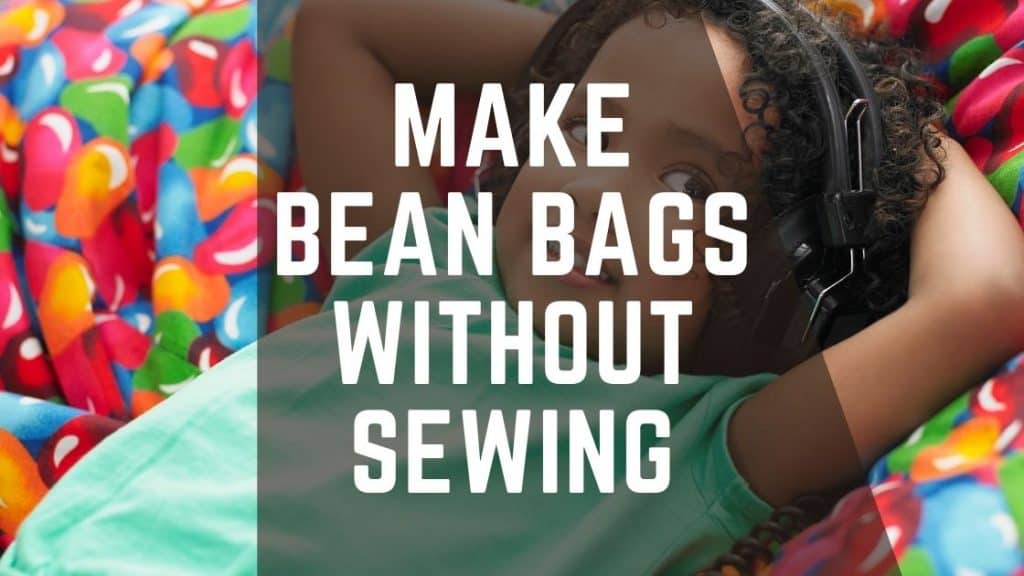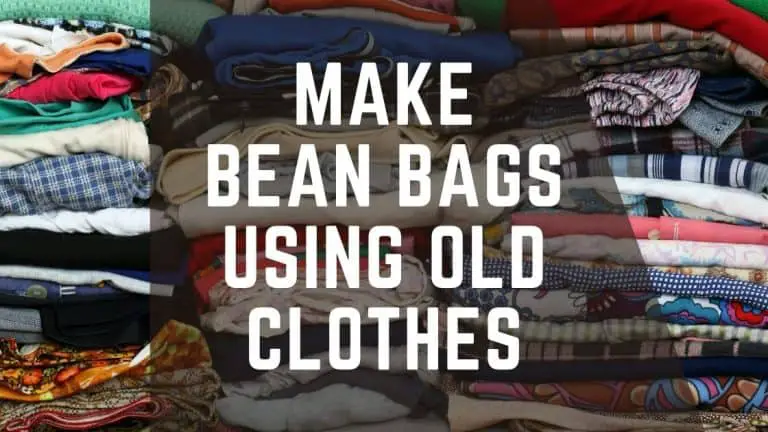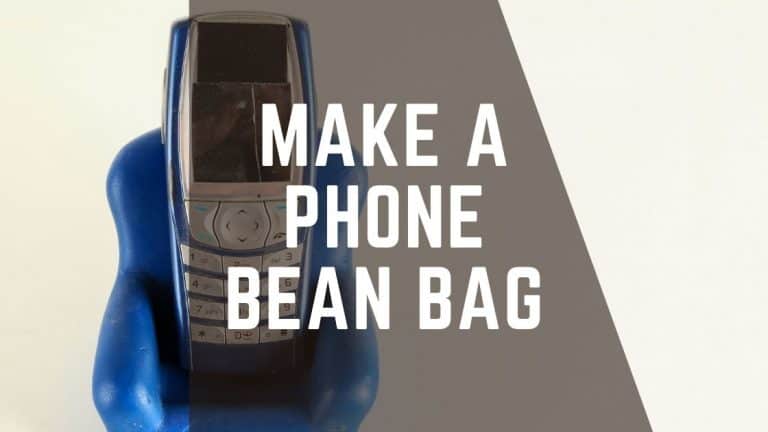Make Bean Bags Without Sewing
Sewed bean bags are the most common type worldwide. However, sewing needs special tools and some skills. So, if you do not have a sewing machine or the skill to use a sewing machine, you cannot make a bean bag at home.
Hence, people are seeking alternative methods to create bean bags without sewing. Thus, we have given you a few methods to make bean bags without sewing in this article. You can practice these methods using general home accessories.
So, let’s see how to make a bean bag without sewing.

Table of Contents
- Make Bean Bag Using Glue
- Make Bean Bag Using a Cotton Code
- Make Temporary Bean Bag Using Pillows
- Final Words
Make Bean Bag Using Glue
Required Materials
- Fabric
- Scissor
- Bean bag fillings
- Marker or pen
- Glue gum
- Glue gum gun
Here I explained how to create a fundamental ball shape bean bag. However, you can customize your bean bag according to your preference. Make sure you have enough fabrics and filler beads to create your dream design.
Step 1: Take suitable fabric that has 56’’ x 56’’ dimensions.
Fabric selection is highly subjective. Thus, you can select the proper materials for your bean bag. The cotton, linen, velvet-like fabrics are better for this method.
Firstly, take two fabric pieces that have 56’’ x 56’’ inches. We need two pieces to create the upper side and backside of the bean bag.
Step 2: Put two fabric pieces together.
Here, first, lay your fabric on a clean flat surface. Then use pins to stable the material.
Step 3: Draw a large circle shape on the fabric.
Use a pen or marker to draw this circular.
But drawing a full circle on the fabric is difficult. You can fold the fabric in half first. Again fold it in half. Then draw a quarter of the circle on the fabric.
In this method, you do not need to draw a full circle. Make sure your draw line should go along the free edges that do not fold.
Step 4: Then cut the circular pieces
These two fabric pieces should have identical sizes. Thus, keep it in your mind and cut it carefully.
Step 5: Draw a bit small circle, 2 inches inside of the fabric piece
These circle marks will help for step 6.
Step 6: Keep two circular fabric pieces together.
Here, you should decide what the original side of the fabric is. Then place these original sides together.
Step 7: Glue and paste two fabrics pieces together
This is the most crucial step of the whole process. Thus, do it with proper care. The total capability and strength of the bean bag depend on the quality and the way you paste fabrics together.
You can plug a hot glue gun and insert a stick of glue into it. Then allow the glue to warm for a few minutes.
Then, start gluing around two inches from the edge. Here, you can follow the circle that draws in step 5. The glue should spread from the edge to that line. Use an excellent sticky adhesive that is specially designed for fabrics.
But do not paste all edges. Allow enough space to add bean bag fillers into it.
Step 8: Allow it to 15 minutes for fully dry
The allowing time may differ with the glue brand. Thus, read manufacturer guidelines first and decide time according to it.
Step 9: Inside out the bag
Now you have a partially finished bean bag cover. Thus, inside out the bag to look at the bean bag outer cover.
Step 10: Fill the beans into it
You can use cotton, expanded polystyrene balls (EPS), old clothes, or another filler to fill this bean bag. However, try to select lightweight filler beads.
The heavily weighted fillers may add extra weights to pasted edges of the bean bag. To reduce this extra pressure and protect seams, use lightweight fillers.
Fill the beans 2/3 of bean bag volume to take a unique, comfy feel.
Step 11: Apply glue on an open area of the bean bag
Fold bean bag open edges 2 inches inside and apply glue. Then join two fabrics each other. Finally, enclose the bean bag.
Step 12: Done. Enjoy your super comfort bean bag.
The seam strength mainly depends on the glue properties. Thus, select the best quality glue that can use to paste fabrics.
Besides filling bean beads directly into the bean bag, you can add them to the inner bag. Then put this inner bag into the prepared bag. It may increase the strength of edges.
Moreover, when you are applying glue, make sure to maintain the firm bond. Do not let any tiny holes appear on the pasted edges.
If you do not paste well or remain tiny hole, bean beads can easily spill out. Safety is our primary consideration; thus, be careful of these types of small facts too. The small space is enough to tear up the whole paste edges of the bean bag.
Make Bean Bag Using a Cotton Code
If you are searching for another method to prepare bean bags without sewing, try the below. It may not take much time, and you can finish the whole process within 30 minutes.
Required Materials
- Bedsheet, Large table cloth, or any other large fabric
- Scissor
- Pen
- Bean bag fillings
- 1-inch perimeter cotton code (1 yard )
Step 1: Take a large piece of circular, rectangular, or square-shaped fabric
As a very first step, you have to take enough fabric to create a bean bag. In here you do not need any special equipment or tool. If you do not have a single piece of large fabric, take a double bed sheet or, large table cloth.
The main thing is that fabric should have enough strength to stand as a bean bag. Moreover, it should have the capability to handle pressure.
Step 2: Draw the best possible circular or oval shape design on the fabric.
Sometimes you may have circular shape fabric. Then draw a circle that few inches inside from the edges.
However, if you have rectangular fabric, draw the best possible curve shape circle. It should be 3,4 inches inside from the edge.
If you have square shape fabric, draw the best possible large circle on it.
Step 3: Cut 1 inch small holes around the edge of the fabric
You can follow the drawn circle lines to cut holes. The perimeter of these holes is not should larger than 1-inch. Cut holes with 3 inches intervals.
These holes are used to add the cotton code. Thus, according to your code size, you can decide the hole size.
Do not cut these holes just near the edges because the fabric can be torn from these sites.
Step 4: Add a knot to one corner of the code and Insert the other end into the holes
Here you should run the code through the holes.
Step 5: Hold two edges of code and reduce the mouth opening of the fabric
Now you can change the size of the mouth opening of the bag using a code.
Step 6: Add filler beads into the prepared bag
You can use cotton, old cloth, rice, small pebbles, packing peanuts to fill the bag. However, my recommendation is expanded polystyrene beads are not safe for use.
Because these bean bags are not prepared with safety standards, beans can easily spill out and cause severe damage.
You can increase bean bag safety by adding fillers with an inner bag. Fill 2/3 of the bean bag using beans.
Step 7: Enclose the bag using a code.
As a final step, enclose the bean bag using a code. You just have to pull code for the opposite directions. After the bag is fully enclosed, tie the code tightly.
Congratulations! Now you are almost done. You can set the folded corner on the top and use this bean bag as a tear shape one.
But if you do not like to show this folded area, just place it into the bottom of the bean bag. Sit there and enjoy the comfy feel!
Make Temporary Bean Bag Using Pillows
Do not have enough resources to create a bean bag? But still, love to sit there?
Fortune treats people differently, so if you do not have enough budget to obtain some resources, let’s start with existing materials.
This is a simple and basic method. The primary purpose of this method is to give a unique bean bag feel to the user. But this feeling is not 100% the same as the original bean bag feel.
Step 1: Take a large bed sheet or table cloth
The double bed size bed sheet is ideal for this.
Step 2: Lay that fabric on the floor
Step 3: Add your extra pillowcases or old cloths to the fabric
In this step, you should add enough fillers to the middle of the bedsheet.
Step 4: Take opposite corners of the fabric and tie it
Just take opposite corners of the bedsheet and tie them. Do not allow fillers to get out from the knot area.
Step 5: Done.
You can set the knot area to the ground floor. Then it will not destroy the beauty.
Take a book and enjoy your bean bag that was made within 5 minutes.
The old clothes, pillowcases are ideal fillers that can be directly used. However, if you want to use other filler types, use the inner bag. It will reduce the risk of bean spills out.
Final Words
Why do we use seams for every fabric product? Can’t we prepare bean bags without sewing? You may have doubts like this. But if you think out of the box, you can find many solutions and easy ways to overcome some barriers. Thus, sewing is not an essential process for a bean bag. You can skip that step and go for a modern one. So, it is your time!





